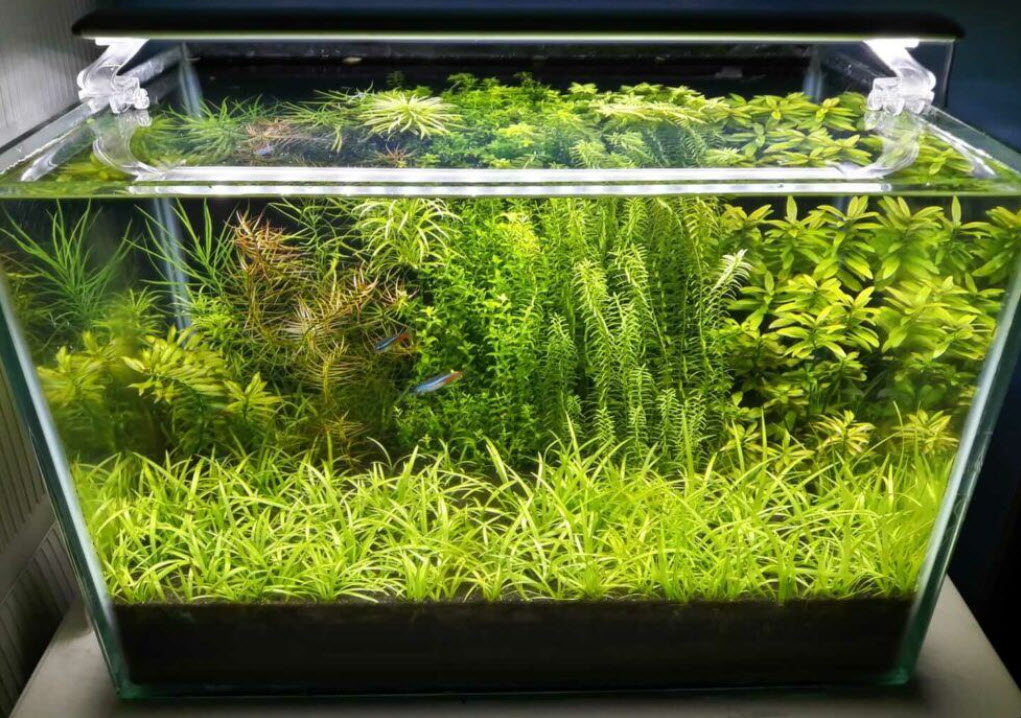
Diana Walstad wrote the “bible” on “low tech” planted tanks. Her book is called “The Ecology of the Planted Aquarium”. If one wants to know this topic in depth from a true expert, I heartily recommend this book (I think I’ve probably read it about five times!). She is the ONLY aquarium book author that “did it right” and based her work on what the scientific articles say about the topic rather on parroted myths and profit minded marketing hype.
I wish Ms. Walstad had written a book on fish aquariums. Her thorough and scientific research techniques guarantee it would have been worth its weight in gold. Unfortunately Ms. Walstad only wrote about the low tech planted aquarium.
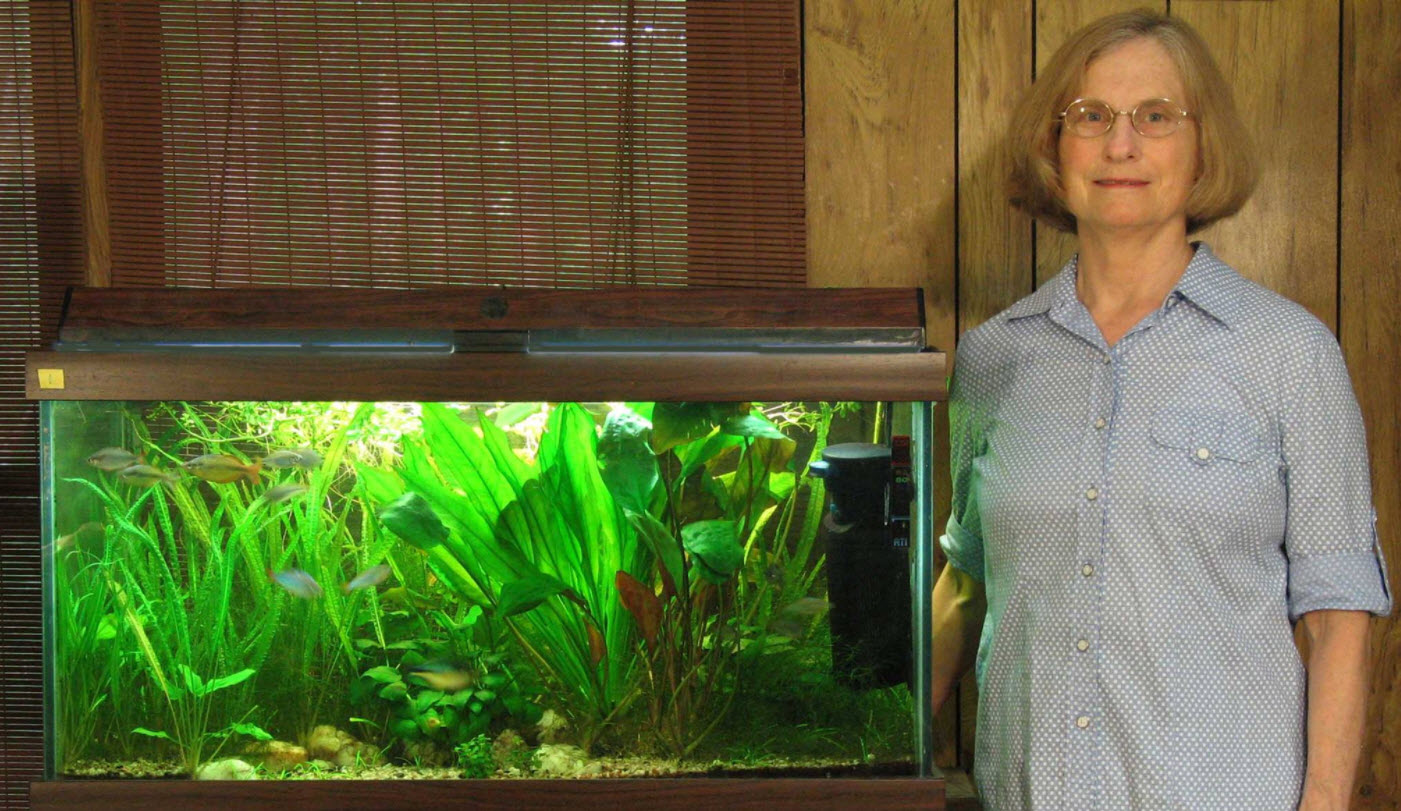
The TYPICAL Walstad aquarium has the following characteristics:
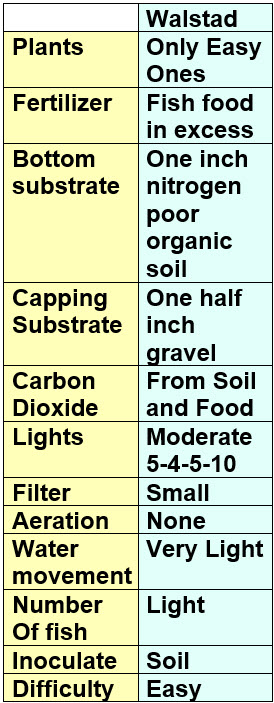
Note this is ONLY a TYPICAL set up. None of these parameters are cast in stone. They can all be changed with success.
In a little more depth, a Walstad aquarium has the following TYPICAL characteristics:
- Substrate: One-inch low nitrogen, organic, CELLULOSE RICH, packaged store bought “soil” underlayment
- Cap: One-half inch to one-inch layer of porous one eighth inch gravel or large particle sand
- Fertilization: Only fish food
- Carbon Dioxide: No CO2 injection, CO2 comes from the soil
- Lights: Moderate powered white LEDs, 4 hours on – 5 hours off – 4 hours on – 11 hours off
- Filter: Initially “none or small filter”, now “some filtration”
- Aeration: None
- Water movement: Some in lower part of aquarium
- Fish: Small number of small fish
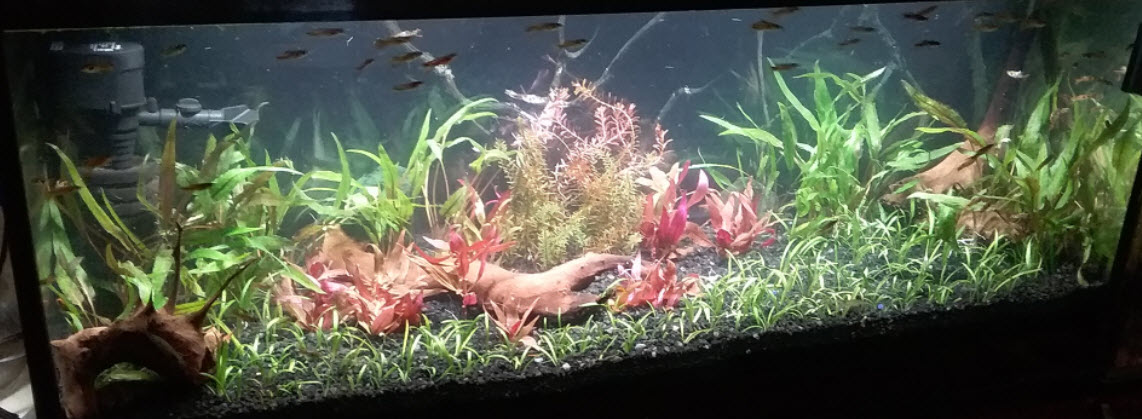
A common misconception is that the “soil” in a Walstad aquarium provide plants with nutrients (nitrogen, phosphorus, potassium, iron). This is not true. The word “soil” is a misnomer. In nature “soil” is composed of largely silt, sand and clay with a small amount of organic material. The packaged “soil” from the store is largely slightly decomposed wood, bark and peat. This is the cellulose rich material used in a Walstad aquarium.
The key here is that the cellulose in Walstad aquarium will raise the carbon dioxide level in an aquarium from 2-3 ppm to 10 ppm or higher overnight. This CO2 enrichment is key to the success of the plants in this “soiled aquarium” approach.
In nature most waterways and lakes have relatively high CO2 levels first thing in the morning. They get this CO2 from rotting vegetation and seepage from underground springs. So a Walstad aquarium just duplicates nature somewhat, where the “rotting vegetation” is the cellulose in the “soil” being used.
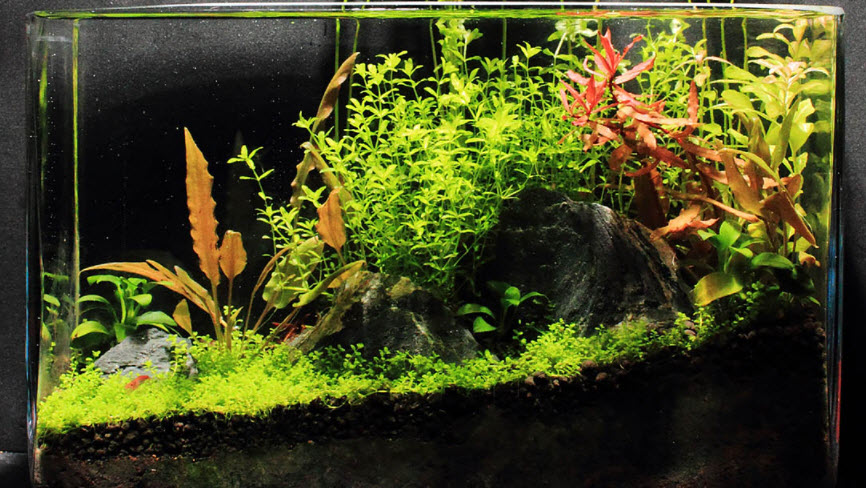
The Walstad Aquarium in Further Depth
I’ll go into some of the more complex issues of a “Walstad” planted aquarium below. This is a pretty long winded dissertation only for real nerds like the author.
Note that the soil substrate in a Walstad aquarium leaches out small amounts of what are called “humic substances” as time goes on. This colors the water yellow to brown. While some like this color I did not and I had to filter with activated carbon to keep the water in my Walstad at crystal clear.
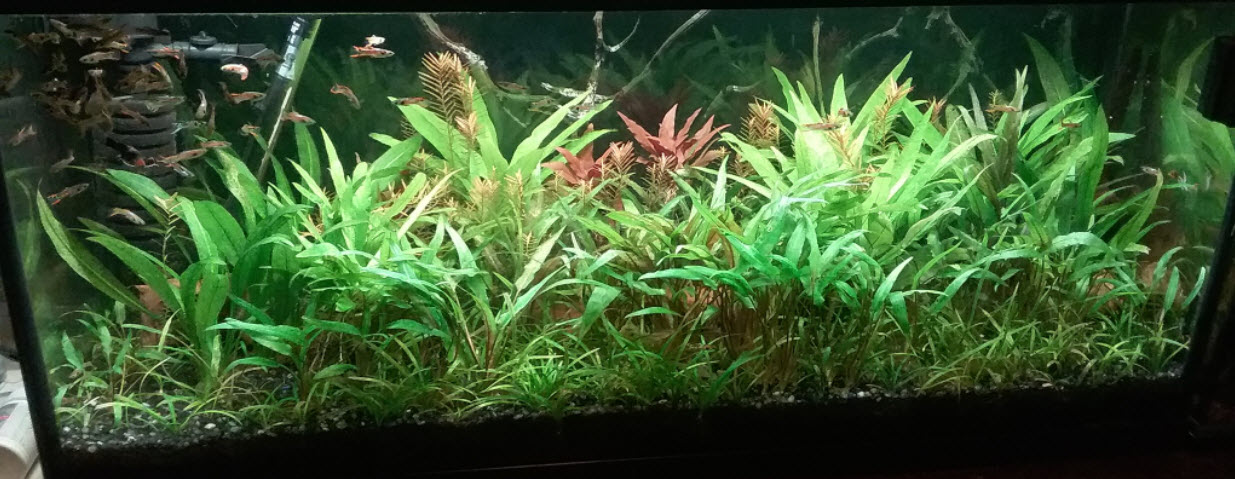
Organic Soil
In general, there are two types of soil sold in big box stores: “organic” and “fortified”. “Organic” soils typically have no added fertilizers and are typically very good for Walstad aquariums. “Fortified” soils have fertilizer in them and generally need to be avoided.
What is often misunderstood about this approach is how the nitrogen level in the organic soil affects everything else. Everyone keys in on “organic” and says: “Won’t that deplete the oxygen and give me very low oxygen conditions in the soil?” The answer depends on the nitrogen. Most “organic” soils purchased packaged in the store are simply cellulose (i.e., wood, bark, and “peat”) in various stages of decomposition.
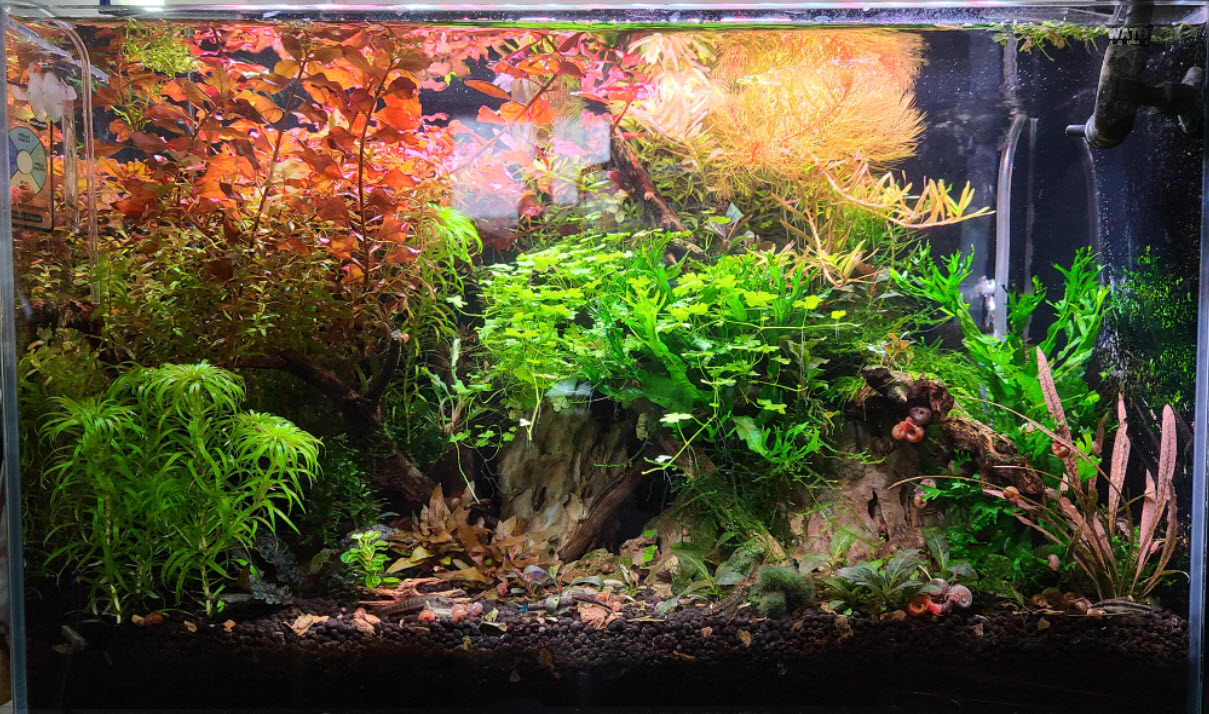
Cellulose does not oxidize readily. Wood (pure cellulose) does not rapidly turn to carbon dioxide and disappear. But mix in some nitrogen into the mix, such as in a fortified soil, and bacteria and fungi can form (bacteria and fungi MUST have nitrogen to form) and somewhat more rapidly turn cellulose and oxygen into carbon dioxide. At some point the oxygen levels get so low the “good” bacteria stop working. And everything then “sours” (hypoxic conditions) and starts producing all sorts of bacterial toxins.
While “sour” soil is not a problem under three inches of aquarium sand (Father Fish method), “sour” soil will be a problem under only one inch of sand. Father Fish’s grand daughter (?), one E.J., tried a one inch cap over a very nitrogen rich soil mix. She got a cesspool. So organic soil is fine as a one-inch underlayment IF AND ONLY IF the nitrogen level is below 0.10% (the first letter of the NPK fertilizer analysis).
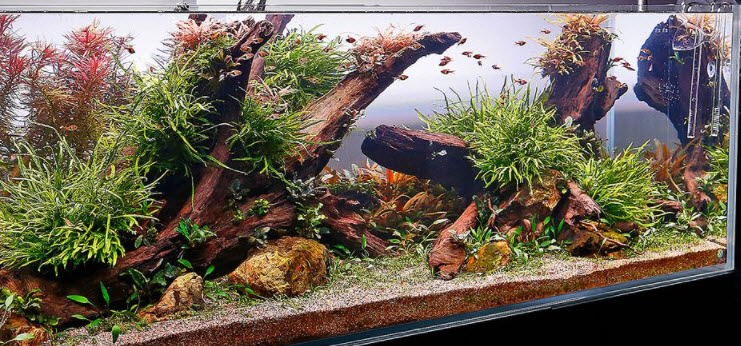
Diana Walstad uses 100% Miracle Gro Organic Choice Potting Mix (MGOC). Unlike many other “potting soils”, MGOC has a clear list of ingredients and a nutritional analysis on the bag:
- 50-55% composted bark
- Sphagnum peat moss
- Pasteurized poultry litter
- “organic wetting agent” (whatever that is)
- Analysis 0.10-0.05-0.05
This is a very good soil for the first one inch in any planted aquarium, low tech or high tech. Alternatives include peat moss and peat. Compost can be used but note the nitrogen normally found in compost can require a lot of water changes initially to remove it from the tank.
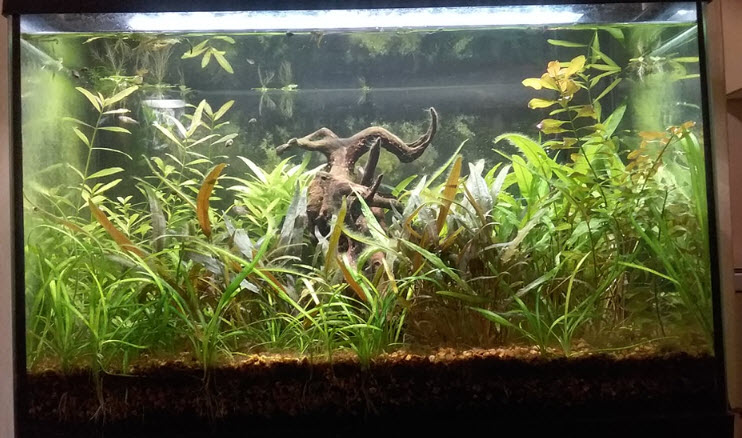
I set up a 55 gallon Walstad with Canadian sphagnum peat moss and it worked very well. I used coarse black diamond blasting media as the covering substrate. And I used a SunSun HW-603B External Canister Filter with a well baffled out flow just above the substrate. I had it for about five years. I did have to use activated carbon to remove the humic acids. I don’t like brown water.
Many say peat moss will be too acid but tests have shown all submerged soils, even those with some peat moss, tend to go to 6.0 to 7.0 pH after several weeks.
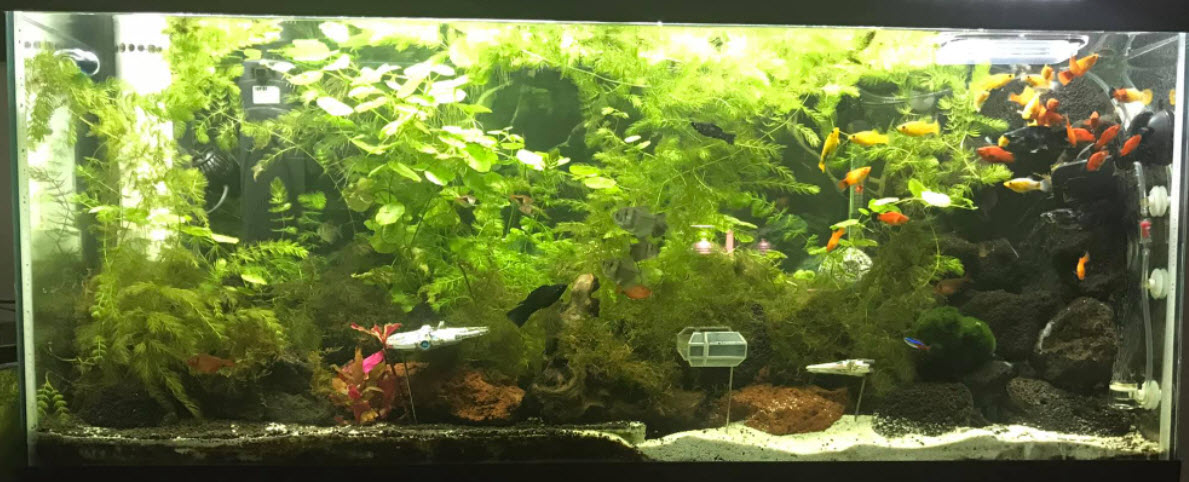
Note one can use another alternative to organic soil. One can simply buy the wood pellets used for wood stoves and put them in as the one inch soil layer. This dense product is simply pure compacted cellulose. Nitrogen, phosphorus and oxygen will slowly diffuse down from the water column into the wood layer. The wood will very slowly decompose, producing carbon dioxide very slowly.
I do recommend a phosphate addition to the wood when setting the aquarium up. This system is gone into in more depth in the following link:
15.10. Hybrid Planted Aquariums
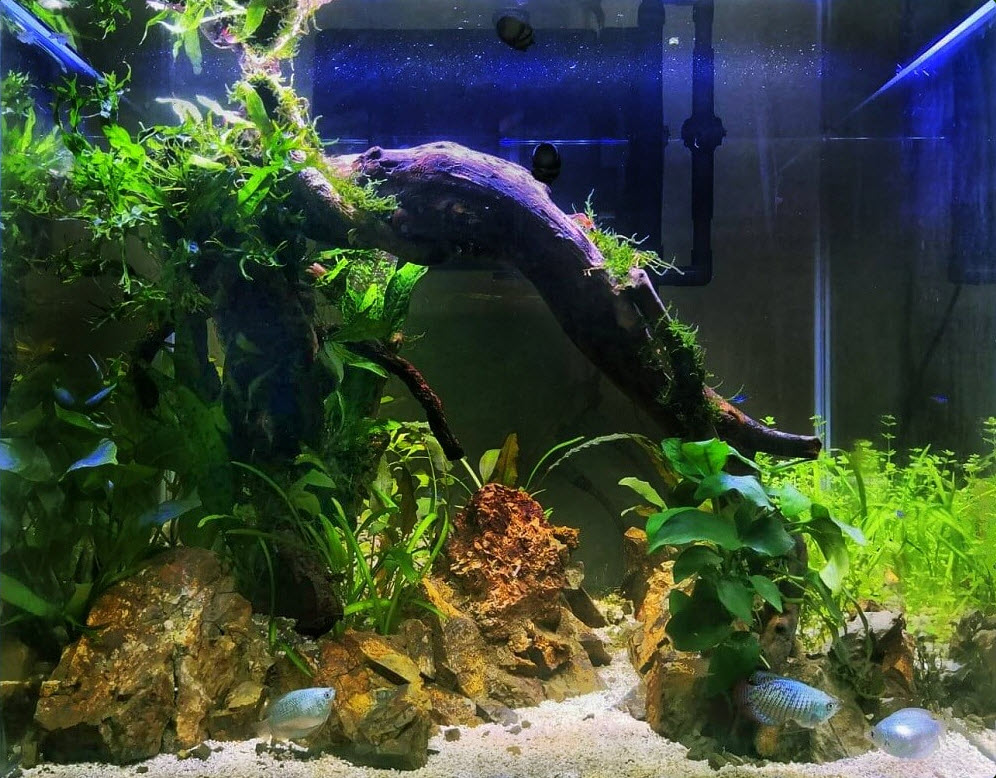
Cap
The “cap” is the layer put on top of the soil. The cap here needs to be porous. It can be either porous small gravel or porous large particle sand. It is important to have SOME exchange between the soil and the water column to keep the soil somewhat aerated. But one doesn’t want to get it too well aerated. Most vascular plant roots do best with oxygen levels at 40% to 80% full saturation.
This porosity is also important to allow the oxygen to diffuse down and slowly oxidize the cellulose in the soil. Then the resulting carbon dioxide can diffuse upward.
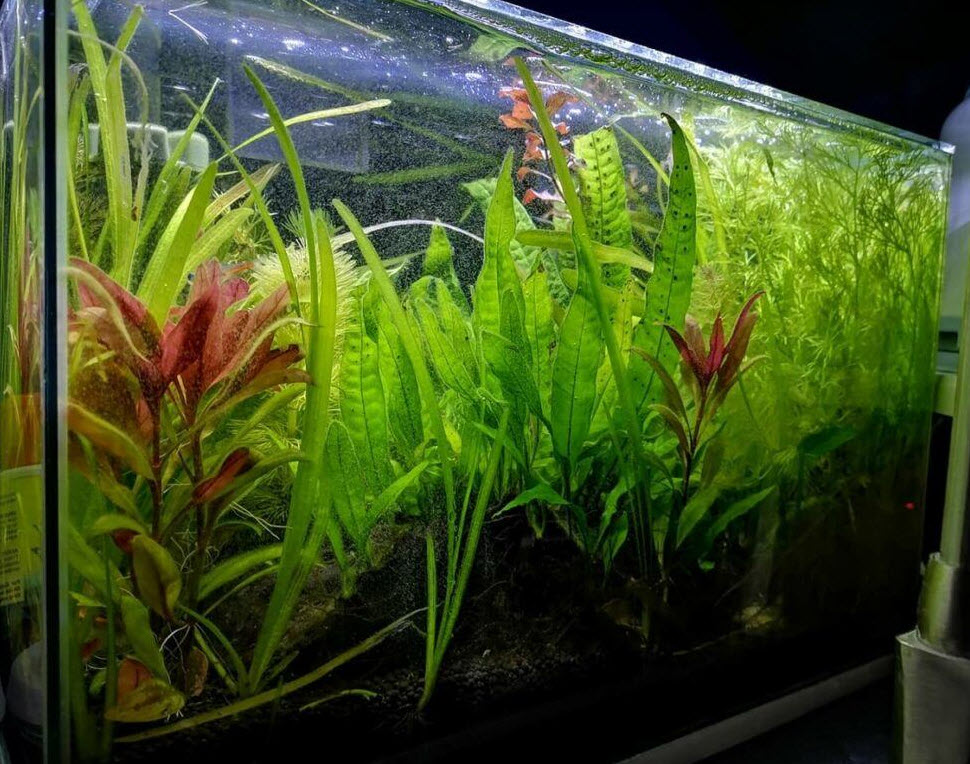
Fertilization
Ms. Walstad uses only fish food for her fertilizer. She adds an excess of food and allows the rotting food to provide ammonia for the plants. She did not use any biofiltration with her first set ups. As a result of both these things Ms. Walstad had an outbreak of mycobacteriosis in her tanks.
Rotting fish food in the water column will give you a lot of heterotrophic bacteria in the water column (the term “heterotrophic” simply mean “eats normal food”) IF AND ONLY IF one doesn’t have good biofiltration with a decent filter. This in turn will give one unhealthy fish, with something like mycobacteriosis being expected.
Ms. Walstad now recommends some biofiltration in the tank. Using fish food as a fertilizer will work with a decent amount of biofiltration in the aquarium.
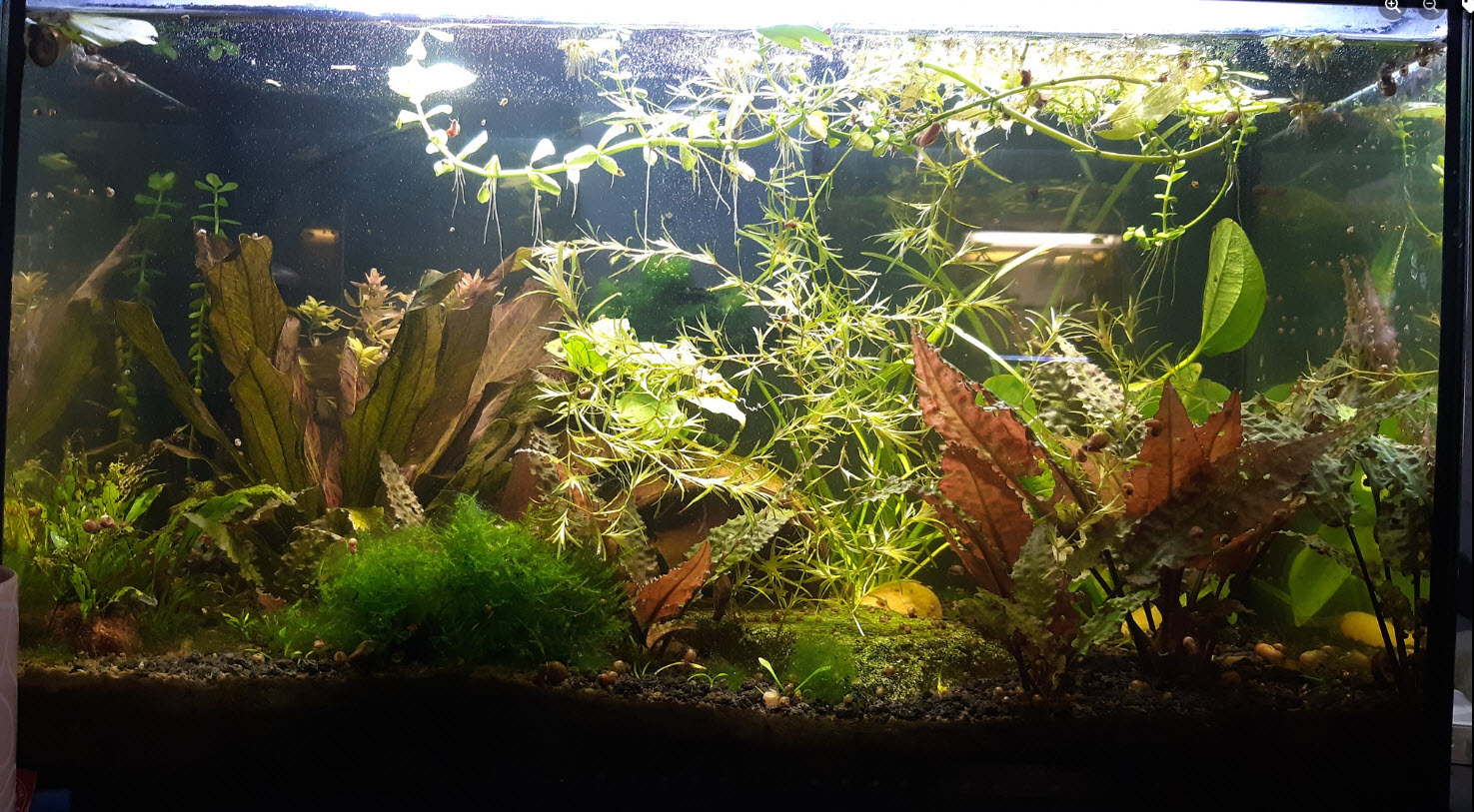
In leu of excess fish food one should add four drops of homemade potassium nitrate liquid fertilizer (potassium and nitrogen) twice weekly per ten gallons in the water column. And use homemade root tabs (phosphorus and iron) infrequently. The formula for making up these fertilizers can be found in this link:
15.5. Aquarium Fertilizing
Note that many “Walstad” aquariums are ONLY Walstad in that they have soil as the first layer of the substrate. Hobbyists then add high powered lighting and tons of chemical fertilization. While these aquariums are NOT “Walstad” they all were doing very well. It just points out that a soil underlayment works well for ALL types of planted aquariums.
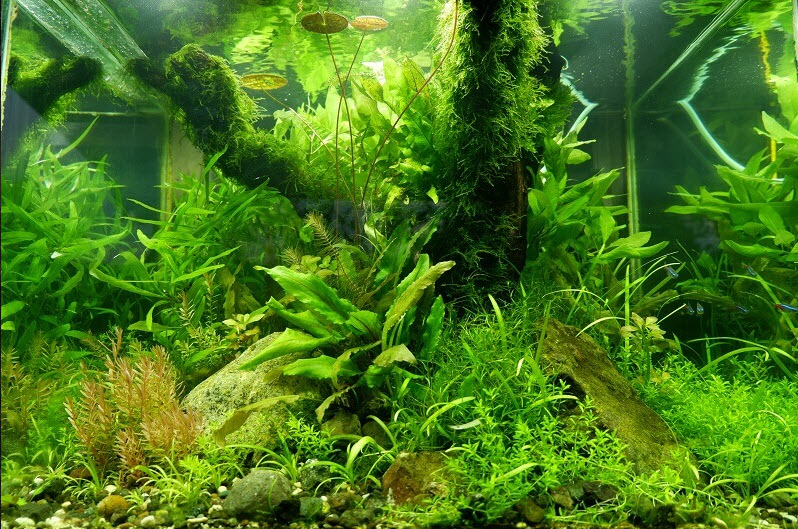
Wood in a Walstad
Ms. Walstad warns against using wood in a low tech aquarium. This is because of a process called “assimilatory denitrification”. Primitive organisms like fungi, bacteria and water molds need several things to survive: carbohydrates, nitrate and phosphate. The cellulose in the wood provides carbohydrates. The primitive organisms then pull nitrate and phosphate out of the water column and incorporate them into their bodies. This means less fertilizer for the plants. And the plants don’t do as well as they would in an aquarium without wood.
If one has wood one will need to provide more fertilizer for the plants. This is easily done if one is using chemicals for fertilization. If one is using food for fertilization one MAY have some big problems, depending on filtration. Note that wood in the aquarium is exactly the same thing as wood under the substrate and will add significant carbon dioxide to the aquarium in exactly the same way. So wood is not really “bad” for a Walstad aquarium. The wood will just require an addition of some chemical fertilizer. This necessary addition is considered “not natural” by the purists.
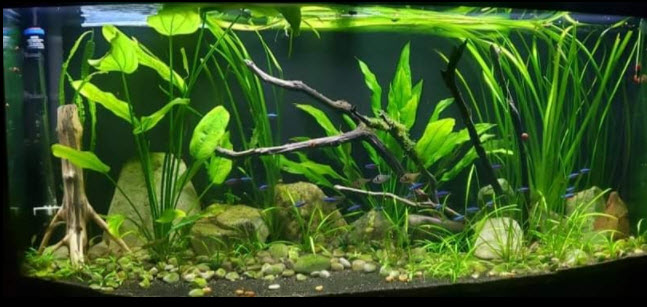
Carbon Dioxide
The Walstad aquarium does not use any carbon dioxide injection. It only uses CO2 from the atmosphere and the natural production of CO2 in the soil substrate. The substrate in an Walstad aquarium will add four to ten parts per million of carbon dioxide overnight. This added injection of carbon dioxide is one of the reasons the Walstad aquarium works so well.
But this also means that in five to ten years the organic cellulose in the soil layer will be depleted and the aquarium MAY stop “thriving”. Note the emphasis on MAY. Sometimes the plant roots take the place of the organics, and the roots may decompose at a similar rate.
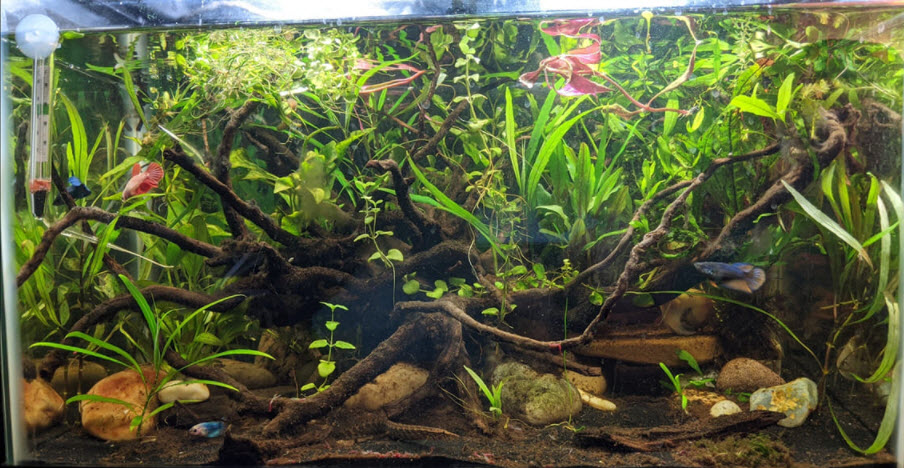
Sanity Check
Let’s do some simple math here. One PPM per 100 gallons is 0.36 grams. One ppm per 20 gallons is 0.09 grams. Many have established that any decent planted aquarium will reduce the CO2 levels from 10 to 4 ppm in two to three hours after a night of percolating CO2 into the aquarium from the soil in the substrate.
This is a usage of very roughly 5 ppm per day of substrate carbon dioxide. 5 X 0.09 = 0.45 grams per day carbon dioxide. Only one third of the weight of the carbon dioxide is carbon. So this is 0.15 grams per day elemental carbon needed in a 20 gallon aquarium. A 20 gallon might have 2 pounds of dry organic soil as the first layer. The organic soil is roughly 50% by weight carbon. 2 x 0.5 x 454 = 454 grams. 454/0.15 = 3,026 days of carbon available, 3,026/365 = 8.3 years.
Now of course this is a VERY rough analysis, but it certainly validates the hypothesis that carbon dioxide from the organic substrate lasts for five to ten years and is a significant factor in the success of the Walstad aquarium.
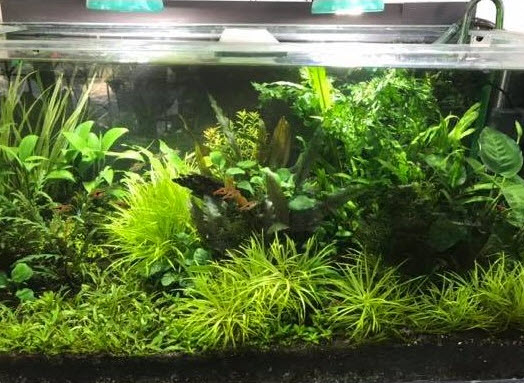
Lights
Walstad aquariums do best with just moderate powered plain white LEDs rather than fancy high powered white-blue-crimson LEDs. Add too much light and the higher plants will be smothered by algae.
Note some put very high powered LED “shop lights” on their Walstad and proclaim that high powered lighting give the best results. LED “shop lights” lack the crimson and blue spectrum that plants utilize for photosynthesis. So if one use LED “shop lights” high power will not be detrimental. If one uses aquarium LED lights that have blue and crimson LEDs, you will typically require only 20% to 30% power.
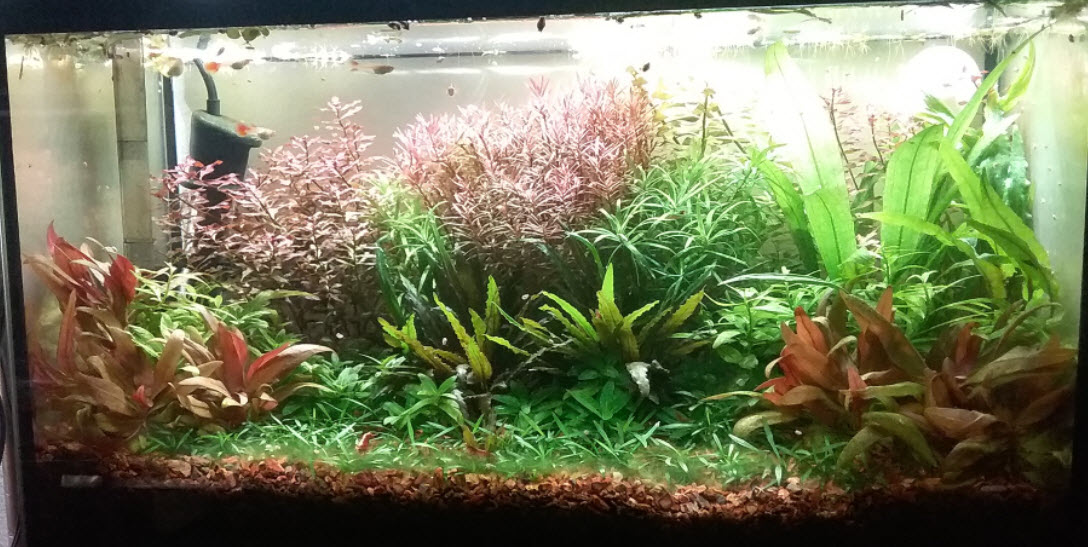
In a tank with only water in it, open to the atmosphere, carbon dioxide (CO2) levels will settle in at about 2-3 ppm. In a typical low-tech tank with an “organic” soil substrate, the decomposition of the cellulose in the soil has taken the CO2 level up to 10 to 12 ppm when the lights come on.
The plants in a well planted tank will then drop the CO2 levels down to 4 ppm after three to four hours of moderate lighting. Algae like low CO2 levels. So it is advantageous with any Walstad aquarium to do something like three hours of lighting on, three hours off, three hours on, three hours off, three hours on, nine hours off. One will get less algae. Ms. Walstad recommends a four to five hour “siesta” in the afternoon where the lights are off.
The stronger the light and the greater the amount of blue and crimson spectrum, the faster the carbon dioxide will drop. This is one of the reasons Walstad aquariums do best with just moderate powered plain white LEDs.
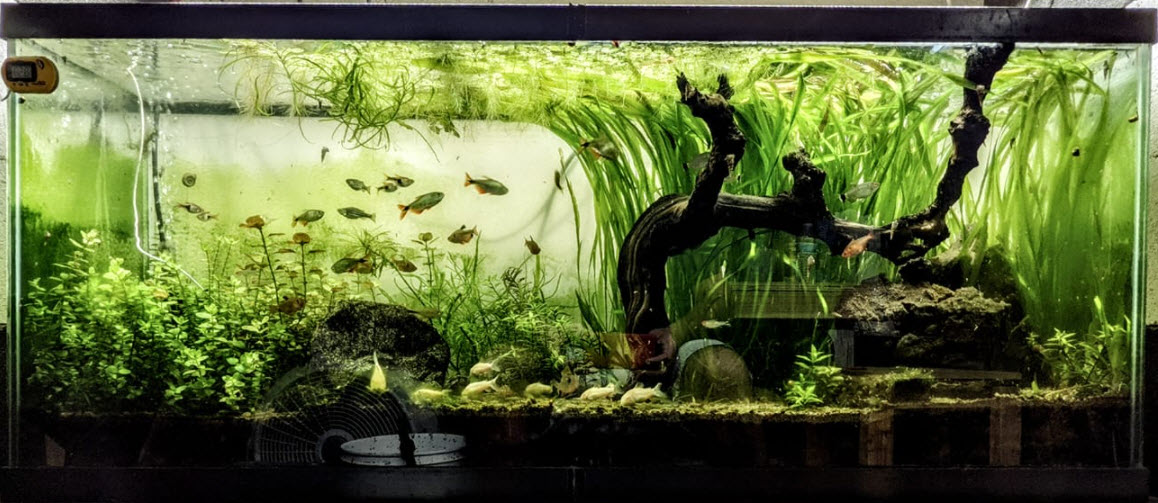
Filtration
Ms. Walstad initially recommended little or no filtration. And she said that the plants will remove all the ammonia just as fast as any beneficial bacteria in any filter. And she was 100% correct about the ammonia. But she has changed her viewpoint and now recommends some filtration. The reasoning has to do with heterotrophic bacteria and water clarity.
Sizable amounts of filtration through something like a small canister filled with sponge keeps the water clear because heterotrophic bacteria on the filter media remove the excess food and dissolved organics from the water column.
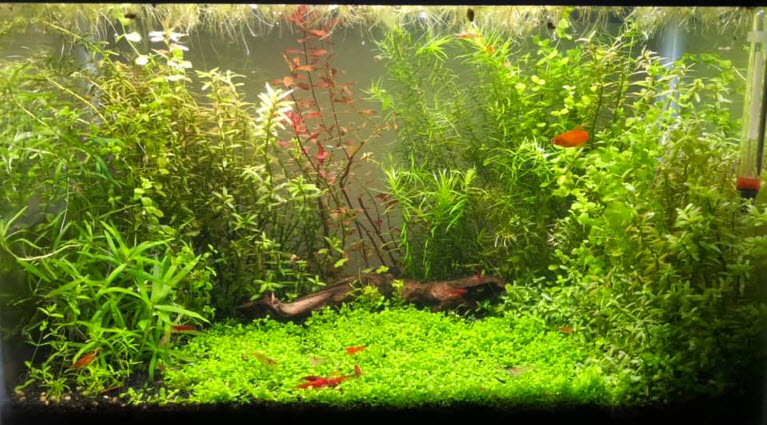
The trick with filtration in a Walstad is to add the filtration in such a way that the outlet of the filter is deep in the aquarium and shoots the water down or across, never up. This is to keep aeration low. Diffuse the water flow via oversized caps that reverse the flow direction and dissipate it.
The Walstad Aquarium below from a YouTube video has great plants and is very well done. But it has no filtration. Note the slightly cloudy water (in the video on YouTube the cloudiness is much more apparent). This is what to expect when one doesn’t use filtration.
There are a whole series of small DIY filter designs that will work very well with this type aquarium (low flow deep in the tank) and can be seen at the following article:
8.7.8. Small DIY Filters
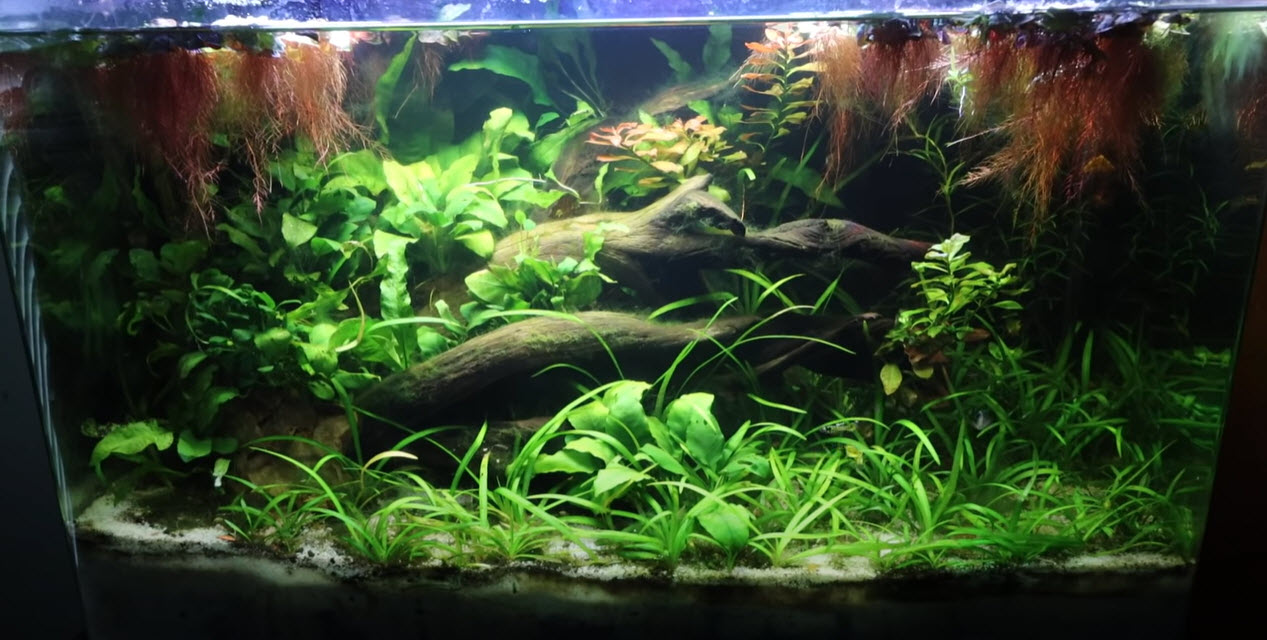
Aeration
Aeration is the enemy of a Walstad aquarium. No aeration allows the carbon dioxide levels to get higher than 10 ppm. Greater than 10 ppm carbon dioxide gives the best higher plant growth. This, in turn, creates a problem having to do with fish stocking.
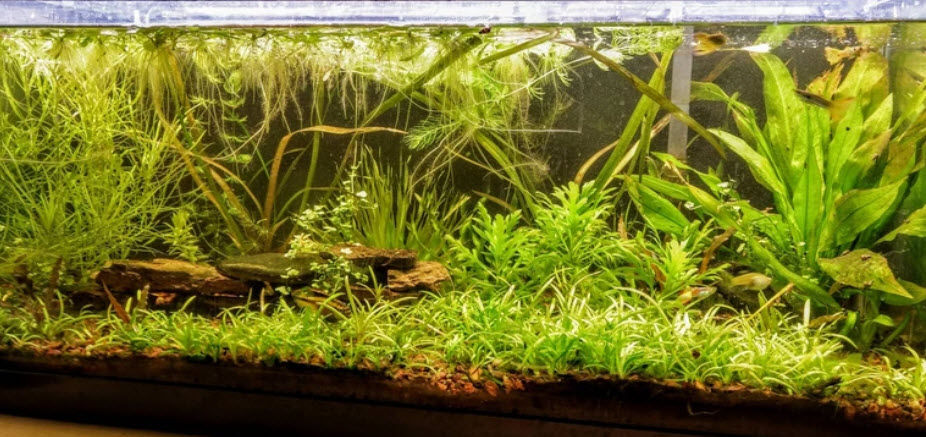
Fish
Walstad aquariums need small stockings of small fish. Most folks understand the linear relationship of the number of fish with relationship to stocking. I.e. four two inch fish consume four times the oxygen of one two inch fish. But most people fail to comprehend the size relationship, which is what is called a cubed relationship. A two inch platy consumes EIGHT times the oxygen of a one inch tetra.
Let us say someone has a ten-gallon Walstad aquarium and puts twenty full grown platies into the tank. And the tank has no aeration. The next morning the hobbyist will awake to twenty dead platies. Note that if one is talking one inch tetras one will need 160 tetras to do the same thing,
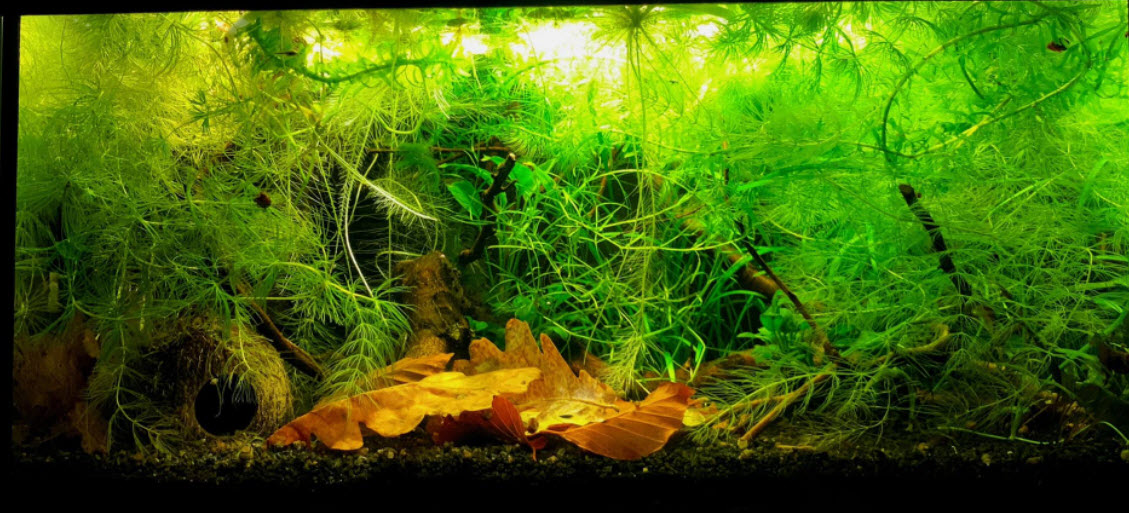
Fish need oxygen. They need a lot of it. And while plants supply oxygen during the times they have light on their leaves, at night plants don’t do that, they even use a miniscule amount of oxygen at night. This aeration problem means that Walstad aquariums require low stocking of small fish. More about what constitutes “light stocking” go to this link:
14. Stocking
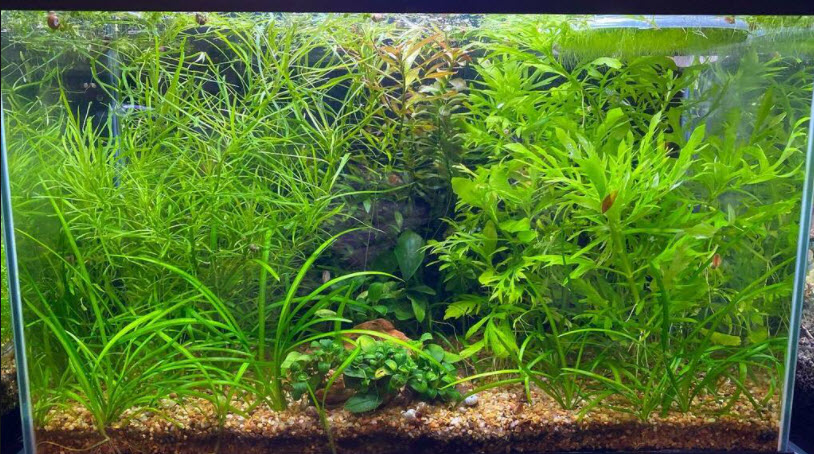
Water Movement
Plants do best with some movement of the water over their leaves. This movement brings the plants the carbon dioxide and nutrients they need. But this movement needs to be very light. “Choppy waves” at the surface need to be avoided as this will aerate the Walstad tank too much. In small tanks this can be a real challenge as even a 5-watt bladed circulation pump is too much current. And air stones need to be avoided.
So for small Walstad aquariums take small 3-watt fountain pumps and direct the flow into a two inch pipe filled with pot scrubbers to do biofiltration. The pipe is easily hidden under the substrate at the back of the tank. The output from the pipe goes from a half inch tube butting into a large one inch PVC cap painted black. The cap dissipates the flow but still allows a little water movement. For larger aquariums the flow can be from a 5-watt powerhead, again, directed into a larger cap to dissipate the flow.
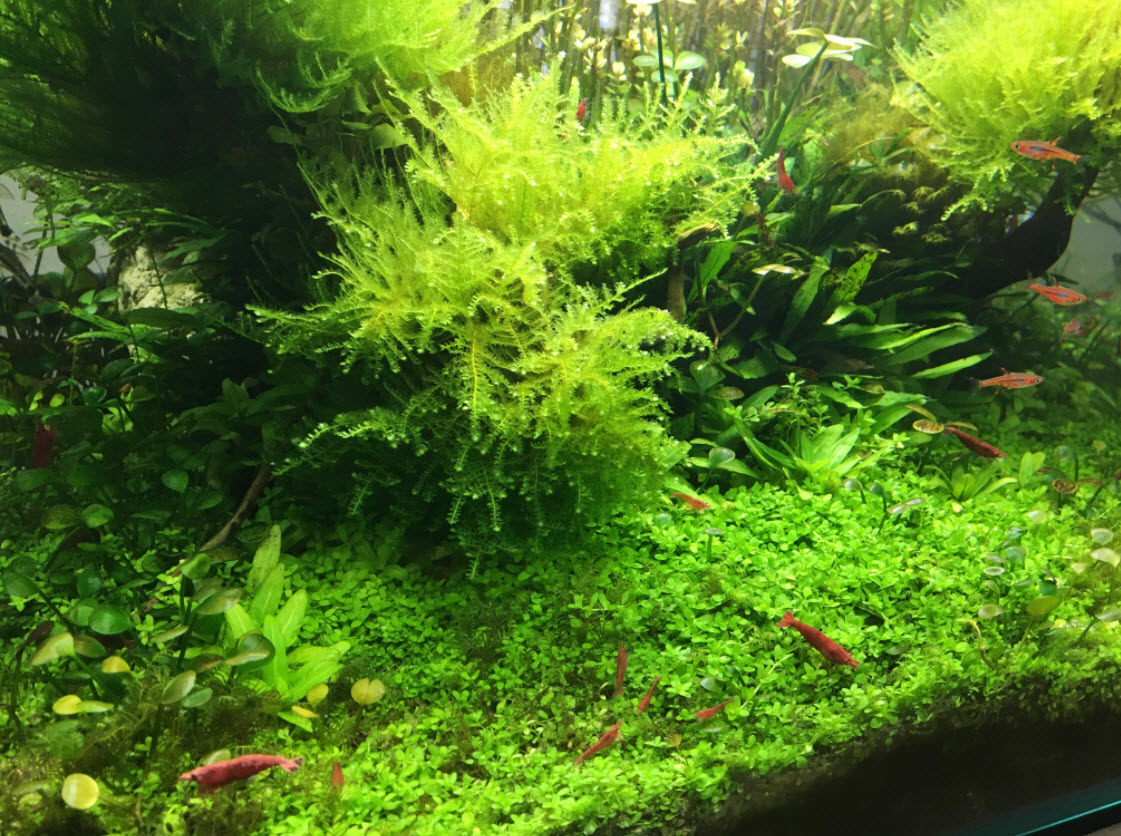
Inoculate
If one uses a sterile soil like peat moss and some packaged soils in a Walstad planted aquarium there can be an issue. The planted tank is a miniature ecosystem. And ecosystems do best with a diversity of creatures in them. The more species of bacteria, fungi, protozoans and metazoans one has in a planted tank the healthier the plants will be. Will a few species be pathogenic? Yes. But they will be outnumbered a thousand to one by the beneficial species.
Both Father Fish and the author go out and get pond mud to inoculate a new tank. Adding one teaspoon dark pond mud to the soil of any planted tank provides something called “biodiversity”. This biodiversity is very important to the health of the plants in a Walstad aquarium. We go into this in more depth in this link:
2.14. The Mature Aquarium
.
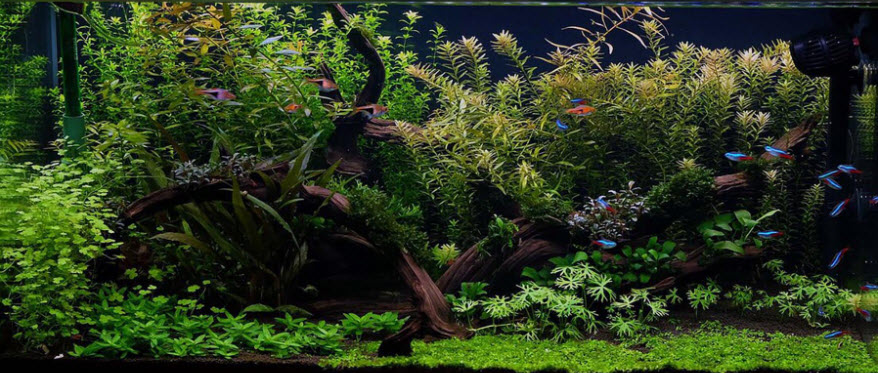
Ammonia Removal
There are largely three separate ways in which ammonia can be removed from an aquarium:
- Plants can absorb it. Plants then use high energy carbohydrates they make using light as an energy source to convert the ammonia into proteins in their bodies. Note algae are plants.
- “Beneficial” or autotrophic nitrifying bacteria convert ammonia to nitrate. They use the very low energy produced by oxidizing ammonia to create proteins they use in their bodies. Plants can and will outcompete “beneficial” bacteria for ammonia.
- Some species of facultative heterotrophic bacteria consume both ammonia and free carbohydrates in the water column (the term “heterotrophic” simply means “”eats normal food”). They use the high energy of the carbohydrates together with the ammonia to create proteins they use in their bodies. Heterotrophic bacteria can and will outcompete both plants and autotrophic bacteria in the absorption of ammonia.
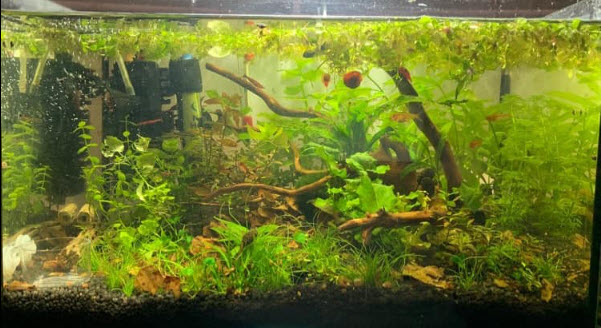
If one adds 8 grams of sugar and 1 gram of ammonium salt to an established unplanted aquarium the ammonia will be gone in two hours. And the aquarium will become cloudy. This is due to the heterotrophic bacteria. Heterotrophic bacteria can out compete plants and autotrophic bacteria for ammonia uptake IF the bacteria have a carbohydrate source.
Most fish food has very roughly 40% proteins in it and 40% carbohydrates in it. So when one adds fish food as fertilizer to a planted aquarium, a goodly portion of the ammonia produced will be consumed by heterotrophic bacteria in the water column. They will use the carbohydrates as their energy source. These heterotrophic bacteria in the water column remove some of the ammonia the plants need and they create unhealthy conditions for the fish.
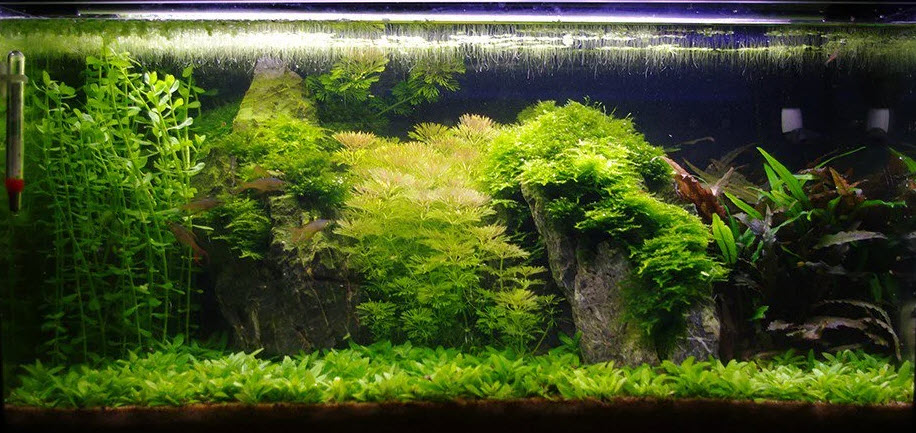
Nitrifying bacteria will not be significant in a planted aquarium simply because nitrifying bacteria use the oxidation of ammonia as their energy source. This very low source of energy cannot compete with the higher energy conversion by plants and heterotrophic bacteria.
What is revealing is that Ms. Walstad had nitrates build up in her aquariums and had to do a water change every four months or so. Ms. Walstad does not actively harvest the plants in her aquariums. Had she harvested the plants she would not have needed to do any water changes.
And let me emphasis that anaerobic reduction of nitrate to nitrogen gas simply does not occur in ANY aquarium, even deep sand bed aquariums. Testing has repeatedly shown this simply is a myth. For more on this go to this link:
14.2.4. The Anaerobic Myth
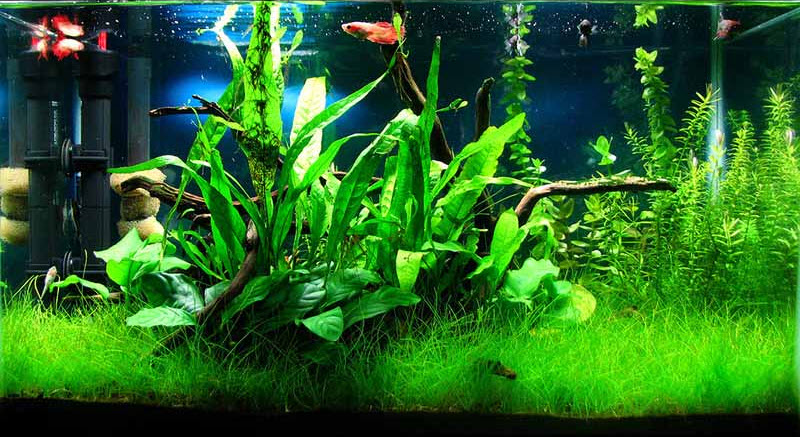
Depleted Substrate
Many who do the Walstad method find that the plants start dying after five to ten years. Many ascribe this to a “depletion of nutrients” in the soil. Since the soil in a Walstad aquarium doesn’t provide nutrient (nitrogen, phosphorus, potassium, iron) this idea is incorrect. The reduction in growth is due to the depletion of the cellulose in the soil and the resulting lack of CO2.

Fertilizer in the Substrate
The Walstad approach emphasizes no chemical fertilizers and a completely “natural approach”. But root tab fertilization of the substrate helps a great deal with Walstad aquariums.
But note that this fertilization has to be a very light handed approach. Use small root tabs sparingly every year. And one should sprinkle some (like half a teaspoon per five pounds soil) calcium phosphate (any form of calcium phosphate purchased from the internet) and some Epsom salts into the soil before laying it down into a Walstad aquarium.
Go to the following link for more on how to do this:
15.5. Aquarium Plant Fertilizing
.
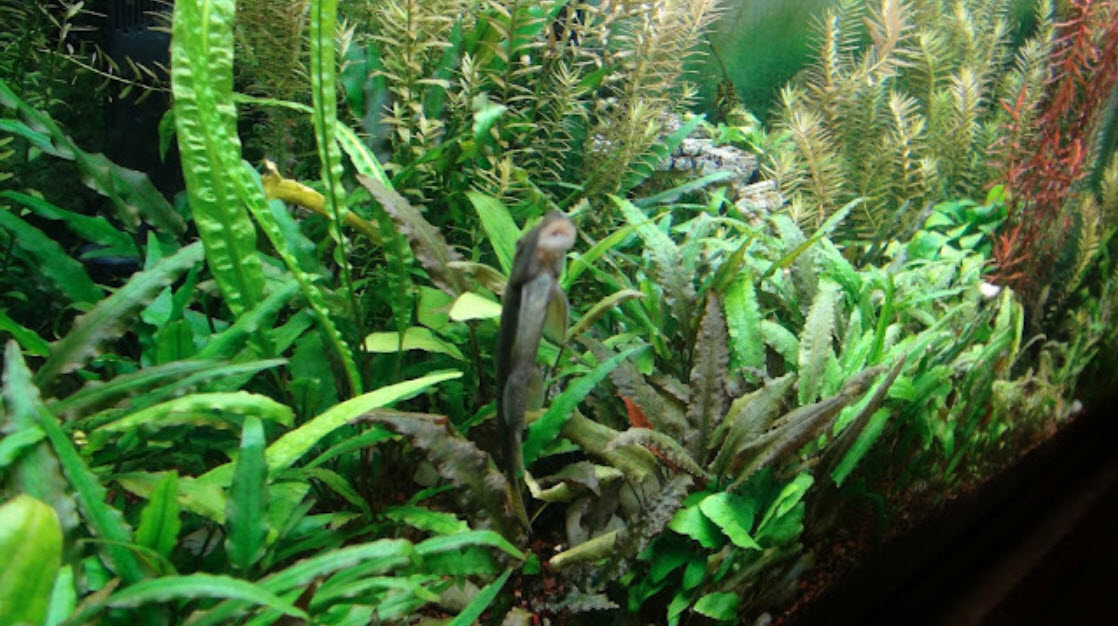
Filtration in a Walstad Aquarium
Ms. Walstad recommends little or no filtration in a Walstad aquarium as “beneficial bacteria compete with plants for absorption of ammonia”. This is one of those area where I disagree with Walstad. Yes, plants absorb ammonia in preference to nitrate. But they still absorb nitrate just fine. Every aquarium plant fertilizer out there that you can buy is a nitrate based formula, including Estimative Index dry fertilizers.
So I add big filters with good media (foam, pot scrubbers of K1) to even a Walstad aquarium. I do outlet the flow deep in the aquarium to prevent CO2 removal by the outlet flow. Yes the beneficial bacteria remove ammonia, but they convert it to nitrate, which plants can utilize just fine. And the filter does so much more beneficially than just ammonia oxidation (disease pathogen removal, DOC removal).
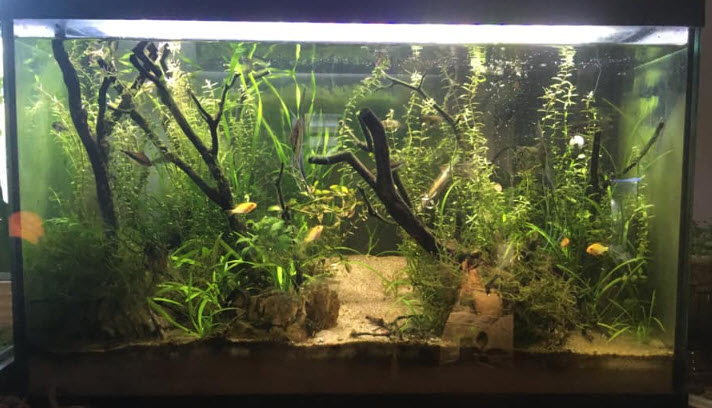
Flexibility
Like all the various aquarium methods we talk about, there is nothing “cast in stone” about the Walstad aquarium. For instance, several of the “low tech Walstad” aquarium photos on this page have obvious high pressure CO2 systems on them. I found better results with my Walstad if I used chemical fertilizers and lots of filtration. A Walstad is a natural ecosystem and Mother Nature is both very forgiving and very flexible.
Planted Aquariums in Depth
The following sections will tell you how to make a planted aquarium:
15. Planted Aquariums
15.1. Planted Aquariums in Depth
15.2. Fish for Planted Tank
15.3. Fish Limitations
15.4. Types of Planted Aquariums
15.5. Fertilizing
15.6. Carbon Dioxide
15.7. Substrates for Planted Aquariums
15.10. Hybrid Planted Aquariums
15.11. Many Fish Many Plants
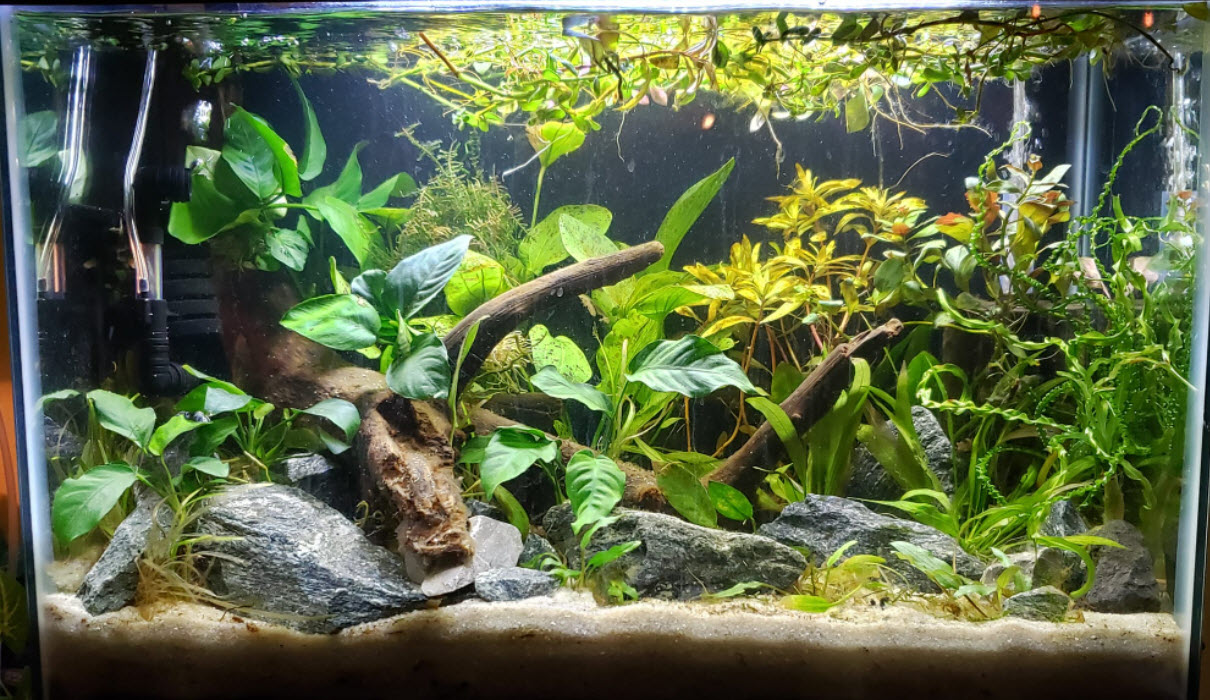
.
Return to Home Page and Main Menu
.
Aquarium Science Website
The chapters shown below or on the right side in maroon lead to close to 400 articles on all aspects of keeping a freshwater aquarium. These articles have NO links to profit making sites and are thus unbiased in their recommendations, unlike all the for-profit sites you will find with Google. Bookmark and browse!
.

Aida says
Hi Dave,
Thank you so much for sharing all those information just in a tip of our fingers. I have 11 aquariums with some of them with FF recipe, but none with Walstad Method. I would love to have a go and the informations you provided enlighten me for a good start.
Confused fish keeper says
So confused. why does everyone talk about nutrients in soil? My new found understanding of the Walsted method is that the soil decomposition is releasing carbon dioxide? AND what about cycling tanks and good/ bad bacteria and all the water changes everyone talks about. Some sources say the bacteria are on substrate and not in the water column. So confused…
Dave says
In reply to Patrick ….. Limit it to one teaspoon. That is all that is needed and more can produce a cesspool.
Patrick says
Hi Dave, is there any reason to limit the pond mud to 1 teaspoon? Or is it safe to put more in?
Thanks!
Puzzled says
Hi David, I think I got it. For a nitrogen & cellulose rich underlayment substrate like in Father Fish, a 2 inch or more sand cap is needed to prevent to prevent bacteria and fungi from fouling the water column. With only a one inch sand cap, the bacterial “bloom” in the underlayment substrate outstripes the oxygen and creates a hypoxic cesspool
Dave says
In reply to Puzzled …. Father fish tried one inch of sand with his method and got a cesspool.
Puzzled says
Hello David, you stated ‘While “sour” soil is not a problem under three inches of aquarium sand (Father Fish method), “sour” soil will be a problem under only one inch of sand.’
I don’t get it. Won’t dissolved oxygen penetrate the one inch sand cap to the cellulose rich substrate easier than in the three inch sand cap? Also, won’t a simple airstone or sponge filter reduce the hypoxic conditions in the substrate?
Thanks
Dave says
In reply to Mike …. Should work. I would use wood shavings (not cedar) to keep everything from plugging up.
Mike says
Hi Dave.
Amazing report and thanks for sharing. I was pondering on trying something new in order to gain c02 in my aquarium saving me the hassle of breaking it all down and start and starting from scratch. I have a planted tank with aqua soil which is doing fairly well. I propose putting either wood pellets in one of my external filters baskets, or miracle grow organic soil in a pourus sack of some kind. I was thinking surely the wood or soil will still decompose in the filter and produce c02? Have you ever tried or heard of anyone that has tried this approach. I have scoured the Internet and found a few people talking about it but no one actually trying it. I am curious if you think it would work?
Thanks again for this amazing website
All the best
Mike